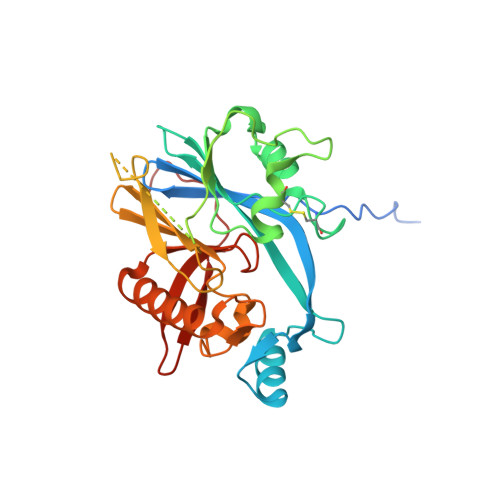Structural and Enzymatic Characterization of the Phosphotriesterase OPHC2 from Pseudomonas pseudoalcaligenes.
Gotthard, G., Hiblot, J., Gonzalez, D., Elias, M., Chabriere, E.(2013) PLoS One 8: e77995-e77995
- PubMed: 24223749
- DOI: https://doi.org/10.1371/journal.pone.0077995
- Primary Citation of Related Structures:
4LE6 - PubMed Abstract:
Organophosphates (OPs) are neurotoxic compounds for which current methods of elimination are unsatisfactory; thus bio-remediation is considered as a promising alternative. Here we provide the structural and enzymatic characterization of the recently identified enzyme isolated from Pseudomonas pseudoalcaligenes dubbed OPHC2. OPHC2 belongs to the metallo-β-lactamase superfamily and exhibits an unusual thermal resistance and some OP degrading abilities. The X-ray structure of OPHC2 has been solved at 2.1 Å resolution. The enzyme is roughly globular exhibiting a αβ/βα topology typical of the metallo-β-lactamase superfamily. Several structural determinants, such as an extended dimerization surface and an intramolecular disulfide bridge, common features in thermostable enzymes, are consistent with its high Tm (97.8°C). Additionally, we provide the enzymatic characterization of OPHC2 against a wide range of OPs, esters and lactones. OPHC2 possesses a broad substrate activity spectrum, since it hydrolyzes various phosphotriesters, esters, and a lactone. Because of its organophosphorus hydrolase activity, and given its intrinsic thermostability, OPHC2 is an interesting candidate for the development of an OPs bio-decontaminant. Its X-ray structure shed light on its active site, and provides key information for the understanding of the substrate binding mode and catalysis.
Organizational Affiliation:
URMITE UMR CNRS-IRD 6236, IFR48, Faculté de Médecine et de Pharmacie, Université de la Méditerranée, Marseille, France.


















